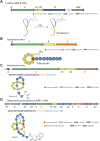Recent Advances and Perspectives on Expanding the Chemical Diversity of Lasso Peptides
- PMID: 34631682
- PMCID: PMC8498205
- DOI: 10.3389/fbioe.2021.741364
Recent Advances and Perspectives on Expanding the Chemical Diversity of Lasso Peptides
Abstract
Ribosomally synthesized and post-translationally modified peptides (RiPPs) are a growing family of natural products that exhibit a range of structures and bioactivities. Initially assembled from the twenty proteinogenic amino acids in a ribosome-dependent manner, RiPPs assume their peculiar bioactive structures through various post-translational modifications. The essential modifications representative of each subfamily of RiPP are performed on a precursor peptide by the so-called processing enzymes; however, various tailoring enzymes can also embellish the precursor peptide or processed peptide with additional functional groups. Lasso peptides are an interesting subfamily of RiPPs characterized by their unique lariat knot-like structure, wherein the C-terminal tail is inserted through a macrolactam ring fused by an isopeptide bond between the N-terminal amino group and an acidic side chain. Until recently, relatively few lasso peptides were found to be tailored with extra functional groups. Nevertheless, the development of new routes to diversify lasso peptides and thus introduce novel or enhanced biological, medicinally relevant, or catalytic properties is appealing. In this review, we highlight several strategies through which lasso peptides have been successfully modified and provide a brief overview of the latest findings on the tailoring of these peptides. We also propose future directions for lasso peptide tailoring as well as potential applications for these peptides in hybrid catalyst design.
Keywords: biosynthesis; lasso peptide; natural products; post-translational modification; synthetic biology; tailoring enzymes.
Copyright © 2021 Wang, Fage, He, Mi, Yang, Li, An, Fan, Song, Zhu and Tong.
Conflict of interest statement
The authors declare that the research was conducted in the absence of any commercial or financial relationships that could be construed as a potential conflict of interest.
Figures








Similar articles
-
Unusual Post-Translational Modifications in the Biosynthesis of Lasso Peptides.Int J Mol Sci. 2022 Jun 29;23(13):7231. doi: 10.3390/ijms23137231. Int J Mol Sci. 2022. PMID: 35806232 Free PMC article. Review.
-
Lasso peptides: an intriguing class of bacterial natural products.Acc Chem Res. 2015 Jul 21;48(7):1909-19. doi: 10.1021/acs.accounts.5b00156. Epub 2015 Jun 16. Acc Chem Res. 2015. PMID: 26079760 Review.
-
Discovery and Characterization of Rubrinodin Provide Clues into the Evolution of Lasso Peptides.Biochemistry. 2022 Apr 5;61(7):595-607. doi: 10.1021/acs.biochem.2c00029. Epub 2022 Mar 17. Biochemistry. 2022. PMID: 35298141
-
Expanding molecular diversity of ribosomally synthesized and post-translationally modified peptide (RiPP) natural products by radical S-adenosylmethionine (SAM) enzymes: recent advances and mechanistic insights.Chin J Nat Med. 2025 Mar;23(3):257-268. doi: 10.1016/S1875-5364(25)60845-4. Chin J Nat Med. 2025. PMID: 40122657 Review.
-
Discovery and characterization of a novel C-terminal peptide carboxyl methyltransferase in a lassomycin-like lasso peptide biosynthetic pathway.Appl Microbiol Biotechnol. 2019 Mar;103(6):2649-2664. doi: 10.1007/s00253-019-09645-x. Epub 2019 Feb 1. Appl Microbiol Biotechnol. 2019. PMID: 30707253
Cited by
-
Cryptic Diversity of Black Band Disease Cyanobacteria in Siderastrea siderea Corals Revealed by Chemical Ecology and Comparative Genome-Resolved Metagenomics.Mar Drugs. 2023 Jan 22;21(2):76. doi: 10.3390/md21020076. Mar Drugs. 2023. PMID: 36827117 Free PMC article.
-
Unusual Post-Translational Modifications in the Biosynthesis of Lasso Peptides.Int J Mol Sci. 2022 Jun 29;23(13):7231. doi: 10.3390/ijms23137231. Int J Mol Sci. 2022. PMID: 35806232 Free PMC article. Review.
-
Leader peptide removal in lasso peptide biosynthesis based on penultimate isoleucine residue.Front Microbiol. 2023 Jul 10;14:1181125. doi: 10.3389/fmicb.2023.1181125. eCollection 2023. Front Microbiol. 2023. PMID: 37497541 Free PMC article.
-
Discovery and Heterologous Expression of Trilenodin, an Antimicrobial Lasso Peptide with a Unique Tri-Isoleucine Motif.Chembiochem. 2024 Dec 16;25(24):e202400586. doi: 10.1002/cbic.202400586. Epub 2024 Oct 23. Chembiochem. 2024. PMID: 39225753 Free PMC article.
-
Merging Flow Synthesis and Enzymatic Maturation to Expand the Chemical Space of Lasso Peptides.J Am Chem Soc. 2024 Jun 26;146(25):17261-17269. doi: 10.1021/jacs.4c03898. Epub 2024 May 17. J Am Chem Soc. 2024. PMID: 38759637 Free PMC article.
References
-
- Arnison P. G., Bibb M. J., Bierbaum G., Bowers A. A., Bugni T. S., Bulaj G., et al. (2013). Ribosomally Synthesized and post-translationally Modified Peptide Natural Products: Overview and Recommendations for a Universal Nomenclature. Nat. Prod. Rep. 30 (1), 108–160. 10.1039/C2NP20085F - DOI - PMC - PubMed
Publication types
LinkOut - more resources
Full Text Sources
Molecular Biology Databases

